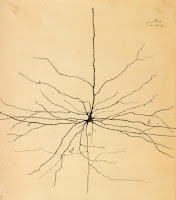`Throughout this week, I have gained
great insights through the lectures and readings especially on the feats
brought about through the combination of math and art, one being that neither
can exist without the other. Linda Dalrymple Henderson’s The Fourth and Non-Euclidean Geometry in Modern Art, Revised Edition, exemplifies on this idea through her studies of
the dimensions and how artists rely on mathematics such as non-Eauclidean
geometry and a 4th dimension of space in the creation of modern art.
In addition to the concept of artists using math to create pieces, Alberti
gives his own definition of a painting stating, “A painting is
the intersection of a visual pyramid at a given distance, with a fixed center
and a defined position of light, represented by art with lines and colors on a
given surface,” strongly suggesting that art is created through mathematics.
Renee Goularte presents a lesson combining the aspects of both math and art.
The beginning of this lesson consists of basic definitions of common terms used
in both subjects, such as a point, line, and pattern, already showing how
interchangeable these two “separate” subjects are.
M.
C Escher is a famous artist who created especially mathematically challenging
artwork. He used mathematical techniques such as division, balance, and
perspective in order to make pieces that would actually be mathematically
impossible in the real world, but accurate in the artwork due to the way the
human eye sees patterns.
These are photos of Escher and one
of his pieces called “Relativity” showing a staircase not mathematically
functional in the real world yet believable to the eye. Art is created through the
understanding of mathematics, and then expanded
on creatively.
This image shows this idea of how a spiral is created, yet made to be
artistic through creative traits such as coloring and shading. Overall,
mathematics and science work together and add to each other, contributing to
the expansion of one another.
Sources:
A
Abbott, Edwin Abbott. Flatland: A Romance of Many Dimensions. New York: Barnes & Noble, 1963. Print.
"Linking Math and Art Through the Elements of Design." Share2learn. N.p., n.d. Web. 10 Apr. 2016
"M.C. Escher." - Gallery. N.p., n.d. Web 10 Apr. 2016.
"
O'Connor, J. J., and E. F. Robertson. "Mathematics and Art - Perspective." Mathematics and Art. N.p., Jan. 2003. Web. 10 Apr. 2016.
"The Mathematics of Art - Math Central." The Mathematics of Art - Math Central. N.p., n.d. Web. 10 Apr. 2016.

 I went to the Hammer Museum on Saturday June 3rd and viewed "The Desert People" gallery. The gallery consisted of digital aspects that correlates greatly with the main focus of the class. For example, its centerpiece was a 16mm film that has been transferred to DVD. This experience consisted of creativity and science working together to create a film. Artists such as David Lamelas lead the way for modern day design and media arts concepts because of his unique way of viewing the world.
I went to the Hammer Museum on Saturday June 3rd and viewed "The Desert People" gallery. The gallery consisted of digital aspects that correlates greatly with the main focus of the class. For example, its centerpiece was a 16mm film that has been transferred to DVD. This experience consisted of creativity and science working together to create a film. Artists such as David Lamelas lead the way for modern day design and media arts concepts because of his unique way of viewing the world.  This film and the artwork overall represents the experience of a group of people who travel to a reservation located in the south eastern United States and depicts their story through artistic aspects yet at the same time uses the addition of seemingly random scenes to portray a sense of parallel of the disorientation and bewilderment of people traveling. One of the main ideas of the film is to call attention to the subjective nature of both truth and meaning. Lamelas does this by the adding in the seemingly random scenes and interviews to the film to where the film doesn't seem to flow anymore.
This film and the artwork overall represents the experience of a group of people who travel to a reservation located in the south eastern United States and depicts their story through artistic aspects yet at the same time uses the addition of seemingly random scenes to portray a sense of parallel of the disorientation and bewilderment of people traveling. One of the main ideas of the film is to call attention to the subjective nature of both truth and meaning. Lamelas does this by the adding in the seemingly random scenes and interviews to the film to where the film doesn't seem to flow anymore. 


















![[ankle.JPG]](https://blogger.googleusercontent.com/img/b/R29vZ2xl/AVvXsEhPzw9HTYAfmtT-ZzH7oUKEsx735NmfgLzuCDKk2m9uQPXmteXKwCZcg5nlQ7ll5eEY6R_v54r06nH672nN1Ak3VAlmUDMlVlkojktS3tNvqRvXu90lJQvlTEpz46eKioe-15slCcCO-S1N/s320/ankle.JPG)